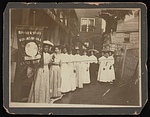The Unfinished Journey to Equal Suffrage
The fight for the passage of the 19th Amendment, which gave women the right to vote, took over 70 years. Leaders of the women’s rights movement, like Susan B. Anthony and Elizabeth Cady Stanton, devoted their lives to radically demand full citizenship in a country that had, since its founding, treated them as second-class citizens. They were revolutionaries, committed to abolishing a system that was designed to exclude them, imagining the possibility of building something new. Victory was unlikely.
But despite the fact that these leaders claimed to be fighting for human equality, Black women were regularly excluded from the mainstream movement.
When Stanton found out that the 13th, 14th and 15th Amendments, which abolished chattel slavery, secured a more expansive definition of citizenship, and granted suffrage to Black men, didn’t include women’s suffrage, she used racial slurs to suggest that white women, the wives and mothers of the white men in power, deserved the right more than Black men did. Anthony stated “I will cut off this right arm of mine before I will ever work or demand the ballot for the Negro and not the woman.” For many of these women, the fight for the right to vote really meant white women’s right to vote.
Black women like Frances Harper, Sojourner Truth and Mary Church Terrell tirelessly fought for equality for all, despite rejection and bigotry from many white suffragists. The scholar bell hooks explains, “The women’s rights movement…exposed the fact that white women were not willing to relinquish their support of white supremacy to support the interests of all women. Racism in the…movement…was a constant reminder to black women of the distances that separated the two experiences, distances that white women did not want bridged.”
One event that encapsulates this flawed contradiction is the 1913 Suffrage March. The 19th Amendment, brought before every Congress since 1878, had yet to pass. So, the day before Woodrow Wilson’s inauguration, over 5,000 women took to the Washington DC streets in protest. Ida B. Wells, a suffragist who was born into slavery and became a legendary investigative journalist through her life-risking reporting on lynchings, attended. Upon her arrival, she was told that Black women would be segregated at the back of the procession, so as not to “offend” white participants. Wells rejected this disrespect, and, without permission, marched at the front, just one example of her profound courage at the intersection of racism and sexism.
In 1920, 131 years after our Constitution’s ratification, the 19th Amendment passed; it was a victory won by brilliant strategizing, persistent pressure, protesting and lawbreaking. And even though Black women were essential to this success and greatly in need of political empowerment to protect themselves, the rise of Jim Crow-era laws made it nearly impossible for them to vote. They faced all kinds of racist obstacles, from literacy tests to poll taxes, to violent intimidation. They weren’t the only women left behind - indigenous people were banned from US citizenship until 1924 and Chinese immigrants until 1943. Even as citizens, they were up against similar voter suppression laws as was the Black community.
While many white suffragists retired, Black women continued to fight. When Fannie Lou Hamer, a civil rights activist, tried to register to vote in 1962, her group’s bus was harassed by police on the 26-mile drive home. The next day, she was kicked off the plantation she had lived and worked on for 18 years. Days later, the home where she was staying was shot up by white men. Rather than be silenced by this terrorism, she worked to register others. In 1963, on the way home from a registration workshop, she was arrested and brutally beaten in jail. In 1964, she gave a testimony of this experience at the DNC. President Johnson held an impromptu press conference at the same time to interrupt her speech from being nationally televised live, fearing the political impact of her powerful story.
Black women won legal protection for their right to vote 45 years after the 19th Amendment, when the 1965 Voting Rights Act outlawed discriminatory voting restrictions. It was passed months after heinous police brutality against protesters in Selma, Alabama, where 1-2% of eligible Black citizens had successfully registered. Finally, it seemed that America was coming closer to the democratic promise of “one person, one vote.” More women were able to register than ever before. Until 2013, when the Supreme Court gutted the Voting Rights Act, claiming that it had done its job and was no longer needed. In Justice Ruth Bader Ginsburg’s dissent, she stated that throwing out voter protection “when it has worked and is continuing to work…is like throwing away your umbrella in a rainstorm because you are not getting wet.” Days after this ruling, voting restrictions passed across the country, disproportionately impacting people of color’s access to the ballot.
When we celebrate 100 years of women’s suffrage, we risk erasing the reality of non-white women and oversimplifying a history that reveals just how precious and powerful the right to vote truly is. In 2020, US citizens face voter suppression, gerrymandering and discriminatory practices specifically designed to undermine their communities’ political power. If we want to live in a true democracy, fighting for equal voting access and empowerment for every American is the very first, unfinished step.


